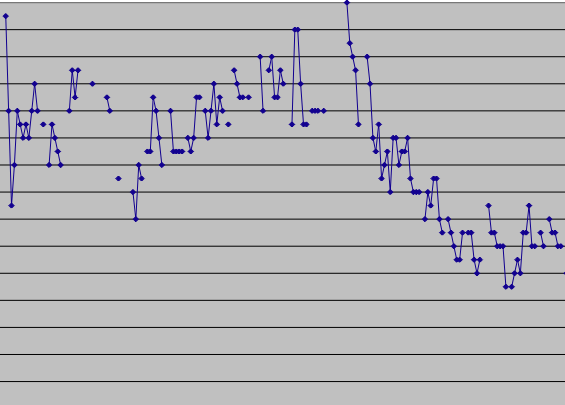links for 2009-08-27
-
What a great observation by Sally Vance-Trembath in this week's letters section: all the people at the healthy lunch conference in the photo are overweight
« July 2009 | Main | September 2009 »
I've been watching with amusement the recent recent fuss about line diets hitting the blog world, for I've been doing this for a number of years, and I had no idea it was actually called something.

Back in 2005 I started tracking my daily weight in an Excel spreadsheet. The system was simple: weigh myself, go into work, jot it down. I did it at work because I kept a second tab in the spreadsheet and tracked my caloric and fat intake each day. I set consumption goals, and after lunch I'd know how much room I had left for dinner and dessert.
I've never blogged about it because, frankly, I found it to be a rather poor diet tool. It was a terrific learning exercise--I'm far more cognizant now about just how fattening food is.
But the spreadsheet, while a fun game, was not much of a motivator. Yes, I wanted to make a pretty declining trendline, and to punch the lower limits of the chart. But I didn't find that any more satisfying than simply stepping on the scale in the morning and seeing how I did. Data points, to me, were decidedly unsexy.
I kept returning to the spreadsheet on and off into 2008, mostly for the daily food lists, which were better at keeping me honest (and just a label-reading version of Weight Watchers' point system). Then I gave up, got really fat, and have lost weight in the past year simply by convincing myself to snack less. Spreadsheets are great, but they don't provide willpower. And on a successful diet, a spreadsheet is redundant--the evidence is in the mirror.
My fifth headphone review went live on Boing Boing Gadgets Friday, marking the midpoint in the series I'm doing this summer. I'm penning 10 pieces covering 11 models from seven different manufacturers.
And what have I learned? More than I expected, some of it obvious, others less so:
This project has been a ton of fun, and I haven't even written about the fancy models yet. My continued thanks go out to Rob Beschizza and Joel Johnson for giving me the platform.
OK, Mr. or Mrs. Consumer, riddle me this.

Which of the above buildings sells pizzas, and which sells radios?
I ask because of some aggressive and misguided rebranding efforts going on by major retail chains. In an effort to both be trendy and transcend an existing identity, they're seizing the playful halves of their names and marketing around them.
Which sounds great, until you take them out of context.
Pizza Hut thinks its consumers already use "the Hut" as shorthand, so they've embraced it as a marketing initiative. That's fine enough, but it doesn't scale. The Hut doesn't mean anything if it's not related to mealtime and pizza, and it won't catch the eye of someone looking for food.
Meanwhile, Radio Shack has decided to do the same thing. They, too, say their shortened "the Shack" is used by devoted fans, and that the name is more trustworthy than the official brand. Except, erm, it really isn't.
When does a nickname imply trust? When it comes from a customer, it says, "I go here all the time," which can be construed as, "I trust their products." When it comes from the corporate mouth, the message is, "You should be my friend," not, "You can trust me." It feels entirely different.
But my biggest complaint is with the brand identity these nicknames create. Not only are the messages missing their mark, but they've gone so far as to become more or less identical. What do they mean? Tell your coworker, "I'm going to the shack and the hut at lunch," and see what happens.
I'm all for nicknames; my coworkers have several for me (and probably a few that I don't know about). But the best ones are descriptive and add warmth and depth to the thing they describe. Shacks and huts, for all their marketing efforts, don't really do that.
This is a cross-post from aiaio.